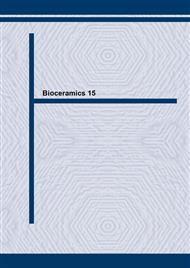[1]
M. Jacho, J. L. Kay, R. H. Gumaer, H. P. Drobeck: J. of Bioengeneering Vol. 1 (1977), p.79.
Google Scholar
[2]
T. Kokubo, M. Shigematsu, Y. Nagashima, M. Tashiro, T. Nakamura, T. Yamamuro, S. Higashi: Bull. Institute for Chemical Research, Kyoto University. Vol. 60 (1982), p.260.
Google Scholar
[3]
J. Wilson, A. Vli-Urpo, R.-P.Happonen: in: L.L. Hench and J. Wilson (Eds.): An Introduction to Bioceramics, World Scientific Publ., Singapore (1993), p.63.
Google Scholar
[4]
R. Z. LeGeros, J. P. LeGeros,: in: L.L, Hench and J. Wilson (Eds.): An Introduction to Bioceramics, World Scientific Publ., Singapore (1993), p.139.
Google Scholar
[5]
T. Kokubo: Acta Mater. Vol. 46 (1998), p.2519.
Google Scholar
[6]
G. Pezzotti: J. Raman Spectr. Vol. 30 (1999), p.867.
Google Scholar
[7]
G. Pezzotti: Composites Sci. Technol. Vol. 59 (1999) p.821. 0 20 40 60 80 100 Distance behind crack tip, x (Ǵm) Bridging stress,ǻޓ (MPa) hydroxyapatite/silver monolithic hydroxyapatite bovine femur 0 0 200 200 200 0 BR Fig. 4: Linear map of bridging stresses collected in situ by Raman microprobe spectroscopy along the crack wake in various hydroxyapatite -based materials. Fig. 3: SEM micrographs bridging ligaments in: (a) hydroxyapatite/silver composite; (b) bone (bovine femur).
Google Scholar


